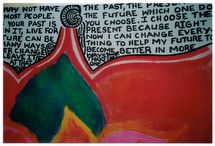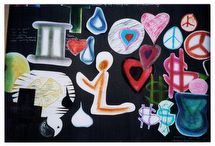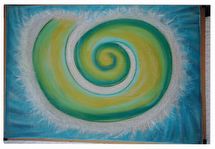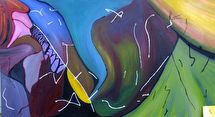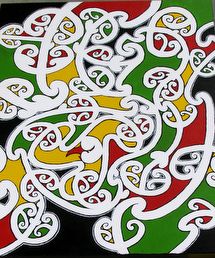
Ngai Tahu, Kati Mamoe, Ngati Kahungunu & Celtic decent ~
arts facilitator, community arts writer, art maker.
PRISON ART IN CANTERBURY PRISONS:
In 2003 and 2004 opportunities were made available to trial a prison art programme, "TOIA'' in Canterbury Prisons. The programme became a model and a basis for other arts initiatives delivered at intervals between 2006 and 2009 in Christchurch Men's Prison, Christchurch Women's Prison, the Youth Unit and the Drug Treatment Unit. Some of these initiatives included the RUIA! partnership and fundraising exhibition auction in 2007, Te Whatukura a Toi - a Whare Wananga (place of learning) project in 2008, and the Heart of a Man programme delivered weekly in the Drug Treatment Unit during 2008 and 2009.
Toia arts programmes
The TOIA Prison Art Programmes were inspired by the biblical principal; ‘…write the idea down, make it plain…’ where visual and language (writing) arts disciplines were used as tools to locate and find a vision going forward into a future.
The programmes focussed on three key areas over a ten week period: to investigate, to talk about, to locate and or to stir an existent hope for life after release. Whether it was a vision, a dream, a goal already known, vaguely assembled or never fully thought through, the programme offered a place to start investigation. The second step was make to art and or to write about how that might look, using a range of visual arts materials and techniques to effectively use them. The third aspect of the programme was to list the known challenges likely to hinder the goal, and most realistic support and management needed to make effective step by step change. A final aspect of the work was formal presentation of ideas to one another, to prison staff and management. Some exhibitions were presented at community galleries where visitor comments were gathered and returned to the men and women along with documentation of the work, photographs and media coverage.
Exhibitions included:
- Nga Kakano (the seeds) - Drawings and writings by women in Christchurch Women’s Prison 2003
- Crossroads - Drawings and writings of youth in Canterbury Prison 2004, at Crossroads Gallery, Cheviot, North Canterbury.
- Waatea (an opening) - Visual art by women in Christchurch Women’s Prison 2004, shown in Christchurch Women’s Prison entry, and at the public office of Otautahi Women’s Refuge, Christchurch
- Na te Waahi Ngaro (from a hidden place) - Drawings by women in Christchurch Women’s Prison 2004, shown at Christchurch Women’s Prison and at the Crossroads Gallery, Cheviot, North Canterbury.
- Wake & Dream - Drawings and short stories by prisoners in Rolleston Prison Canterbury 2004, shown at the Linwood Gallery, Christchurch
- RUIA! (strip away the sapwood til only the heartwood remains) - a first ever prisoner art fundraising exhibition and auction shown at the Gymnasium in Canterbury Prison, raising $28,000 for Family Help Trust and families at risk in Canterbury, May 2007
- Te Whatukura a Toi - A carved and painted whare wananga project by prisoners across Canterbury Prisons. Over 30 large panels 1.7 x 1 metre were installed permanently in the newly named Te Wananga o Te Whatukura a Toi in Christchurch Men’s Prison, 2008
- The Heart of a Man – art and conversation; development of personal mission statements going forward with men in Stage 3 of the Drug Treatment 2008 - 2009
- Kotahi – a performing & language arts Christmas Concert by women in Christchurch Women’s Prison 2009.
Ruia!
Ruia taitea kia tu ko taikaka anake
‘strip away the sapwood so that only the heartwood remains’
An exhibition auction of prisoner art, Friday 4 May 2007
Venue: Gymnasium – Canterbury Prison
Role: Art facilitator / curator / writer
This exhibition auction of prison art was presented by The Department of Corrections in association with Family Help Trust, Canterbury.
The fundraising exhibition auction was just hours in its duration, it was unexpectedly ground-breaking in a number of ways. Firstly, in response to Family Help Trust’s fundraiser, art works made by prisoners were perceived as a way of contributing something back to the community through the sale of work.
Secondly, the Ruia whakatauki proverb was chosen as a theme because of its impartiality and relevance for prisoners and audiences whether incarcerated or free. It suggested that beneath the sapwood - the external props of daily life and living, lies the heartwood of human existence, what we believe and value. It asked the question of its art makers ‘what is heartwood of your life, what is most important to you, when the sapwood is stripped away?
In response, some 150 art works generously reflected expressions of spirit and spirituality, restoration, order, fantasy, flight and freedom. The Mr. Man series of six works illustrated a verse of poetry about a barren land and a windowless church. Feardrops was the handwritten dialogue between the artist and his God. Matauranga Maori (Maori cultural knowledge) was represented through a number of disciplines including the beautifully carved “Mask’. A fluent pen and pastel work, ‘Mauriora’, and skilled acrylic works on canvas had been made by artists using the medium for the first time.
The exhibition provided an insight into the vision, depth of thought, skill and adaptability of prisoners – men, women and youth in Canterbury Prisons. It reflected many different sets of challenges from producing ideas in art mediums never encountered before, working in the prison environment, isolated from the assistance that might have been necessary to complete work. It seemed however, that those very challenges were part of the fuel that prompted the intensity of the work.
Prisoner art makers are a relatively unknown creative voice and sub culture amongst communities and art institutions. It is often a voice of insight and endurance grown from different sets of challenges.
Artist biographies accompanied about 60% of the artworks. Comments reflected responses to the Ruia whakatauki proverb in a number of ways; faith in God, restoration, the importance of whanau family, friends and relationship, matauranga Maori (cultural knowledge), skill development and nature.
Some Prisoner Comments
… ‘Prison has afforded me an opportunity to be still and work on me. I have hope. The whole dark vision of my future has gone. This work stems from a black hole; a history that has propelled my resolve to heal. The focus of the work is 50 cent coins (rings) which represent both myself, and money seemingly wasted. But in truth, the shaping and polishing of the coins represents my life now and a readiness to be propelled forward. (Hope perpetual).
… ‘the teardrops speak of an emotional struggle, guilt, fear, doubt and the struggle to see faith for what it is. Much of my struggle with God came from poor or false information regarding faith. (Feardrops).
… ‘Inner peace is important for families torn apart. This man was stripped away from his village and his people. His freedom was taken away from him. His faith in God and the Spirit within him set him free even through he was incarcerated (Inner peace).
…’ the core of this work is te kakano (the seed) talked about in the whakatauki proverb that says ‘te kakano i ruia mai i rangiatea, kia kore ai e ngaro’ (seed cast in the heavens is never lost). That seed is also in us, in our spirit; we come into this life with it, it is always with us, always prompting, always questioning. (Kakano).
…’the thing that motivates me to carve is to keep the culture and story that came with the carving, alive - to give something back to the community, to set goals and achieve them, to pass on what I have learnt from other people and to teach (Te aio a Hine nui o te wao).
… ‘the hearts represent all of the stages of my life when I was going through hard times, when I was a child and all the way through. The poems around each heart are about people who mean something to me. And the hearts are what my children are missing most, their mother. All I want to do is make things better and the only thing I can do to express my feelings in the hearts and the barbed wire.
The barbed wire means being stuck in a place that makes me only think about your pain and loss. When you look at the barbed wire it may mean something different to you. That’s why my artwork is called what it is. (Life of the heart).
Almost all of the artworks sold and a total of $29,000 was raised for Family Help Trust in Christchurch.
Te Whare Wananga o Te Whatukura a Toi
The naming and blessing of Te Wharekura a Toi
Christchurch Men’s Prison
Friday 14 March 2008
Role: Facilitator
Te Whatukura a Toi was a prisoner led tikanga carving and painting initiative. It came about as a result of discussions between Managers in Canterbury Prisons, the Rev. Maurice Manawaroa Gray, Kaiwhakamana (Maori community advisors to the Department of Corrections) and prisoners.
The outcome of discussions was twofold; to focus interested prisoner art makers into a positive rehabilitative activity and to establish the whare in Christchurch Men’s Prison as a whare wananga, a place of learning.
The project and the whare was named by Maurice Gray as Te Whare Wananga o Te Whatukura a Toi. The meaning is associated with stones contained in the three baskets of knowledge. Toi was the entity associated with whakairo carving, raranga weaving, tukutuku lattice work and kowhaiwhai patterning. Philosophically, Te Whatukura a Toi would be a place of cultural learning.
About 30 art makers were involved in the project over a period of ten months. Each of the works was the responsibility of a lead artist for both its design and production. The 30 works were carved and painted 30 ml MDF wood panels, and two steel panels each measuring approximately 1.1 x 2.4 metres by 20ml. A carved totara pou of four metres and a five smaller painted works were made by youth.
The content of the work was focused away from individual tribal histories and whakapapa, towards generic aspects of Maori life and thought.
The works are installed in the entry to the whare, in the adjacent yard and in the whare itself. At the place of formal entry to the whare in the “D” link corridor was Kaitiaki - three carved panels made up of the amo, (one each side of the door and the pare overarching the door).
In the outer yard, Kohinga was one of two large zinc plated and powder coated steel works made in the Engineering workshops at Kotuku. The work had seven sections and koru within each. The larger koru represented the seven waka while the smaller koru representec whanau, hapu and iwi. In the second steel piece the name ‘Te Whare Wananga o Te Whatukura a Toi was cut from 10 ml steel plate. Both works were zinc plated and powder coated.
Inside the whare Te Manunui a Tane took up an entire wall. This collaboration by carvers and painters in Rawhiti Wing was made up of eight panels. It featured Tane and the birds of the forest as well as the southern eagle, Pou. Images of very large birds found in Kai Tahu rock art sites of southern Canterbury and North Otago were also seen within the works. The panels combined mythology, and existent as well as extinct species of birds and plant life.
Pou: the central work in the whare was carved from old totara sourced from the Reefton area. The carving was started by a well known prisoner artist some years earlier and was completed for Te Whatukura a Toi by three carvers.
Ngakau Wahine: These two large painted panels that stood either side of the pou, were designed and painted by the only prisoner artist to participate in the project from Christchurch Women’s Prison.
In the first of these large works, celestial knowledge was poured out and linked into the second large work, the landscape and surrounds of the maunga Aoraki. The distinctive black and white lines represented the south American and Maori whakapapa markings of a second prisoner artist who included them into working drawings for the project prior to her release.
Two painted panels from Kowhai (Rolleston) talked about Maikinui and Maikiroa; twin brothers who were said to inhabit and occupy the dark world of the human soul. The works represented the forces that need to be known in order to be freed of them.
Maui the challenger and the trickster was the subject of three carved works from Tirohanga Paeroa (TP); one large panel featured Maui and the sun while the two narrow panels (the amo) and single top panel (pare) surrounded the doorways. The latter works as well as the Tunaroa panels were originally made for installation at two public entrances to the whare but were since positioned inside the whare.
Tunaroa: was a work about two entities in mythology – Tunaroa who mistreated the woman Hineatereroa and the intervention of Maui who avenged Tunaroa’s action.
Karanga was a series of six works by youth and presented the landscape and pathways of choice. Central to these images was the putaatara – the traditional taonga puoro musical instrument which in this instance, represented an inner call or inspiration to heed and follow.
Toitu: a large pencil sketch on MDF board was made up of hundreds of thousands of drawn lines. It presented the idea of leaving undisturbed the things that are most valued; wairua, whakapapa, whenua (spirit, people, land).
The art makers taking part in this project were men, women and youth from the units of Rawhiti, Alpha, Bravo, Charlie, Tirohanga Paeroa, Kotuku Engineering Workshops, Youth, Kowhai at Rolleston and Christchurch Women’s Prison.
BIG ‘A’ PRISON ART AWARD RECIPIENT 2007
I was the recipient of the Arts Access Aotearoa Big ‘A’ Prison Art Award for Leadership in the arts in 2007.
The Big 'A' Awards recognizes achievement in pioneering work to utilize prison art as a tool to support positive change for prisoners, their families and the communities they will return to.
Arts Access Aotearoa recognizes individuals and organizations working to enhance the well-being and artistic opportunities of people in the margins such as prisoners, refugees, the young and disadvantaged, and people with intellectual and/or physical disabilities.
The awards ceremony was hosted by Associate Minister for Arts, Culture and Heritage Hon Judith Tizard at Parliament on May 13, 2007.
DEVELOPMENT OF A NEW ZEALAND PRISON ART STRATEGY
The Department of Corrections contracted Arts Access Aotearoa to commence the drafting of a New Zealand Prison Art Strategy to align with it's six strategic objectives, to make best use of its resources and enhance the credibility of arts programmes as a tool in support of prisoner rehabilitation. Through these two organizations, I was contracted as one of three writers responsible for the development of the strategy.
There were immediate environmental impacts influencing development. These were the economic downturn of 2008, subsequent cost cutting by the incoming government and by 2010, a landmark, on-going restructure of the Department of Corrections. The re-structure would bring greater focus to the rehabilitation, reintegration and employment of prisoners - the strategy therefore would need to align with the Department's adjusting and strengthening focus.
The draft strategy document was completed in April 2010. Interim development focussed on the Department's strategic objective to educate and inform staff and public audiences of the value of prison art as a tool of support for prisoners. Arts Access Aotearoa's monthly on-line Prison Arts New Zealand e-newsletter became the tool to communicate prison arts news, stories, profiles, events nationally. It also focussed on prison arts development and research internationally. Prison Arts New Zealand would support a shift in perception - about the usefulness of prison art, and begin to raise the question amongst arts communities about its legitimate place within the NZ arts environment and marketplace.
Equally, the annual Arts Access Aotearoa Big "A" Arts Leadership awards at Parliament would continue to build awareness of NZ Prison Art as a rehabilitative tool by acknowledging prison arts leadership amongst politicians, Ministers, Department management and staff, arts practitioners, specialists and community arts organizations and audiences.
In 2012 Arts Access Aotearoa completed a Prison Arts Planning survey that would provide oversight of the current status of prison arts in the restructured environment in prisons across the country. The survey will support effective prison arts planning and inform on going development of the New Zealand Prison Art Strategy. Listed here are some links to the Arts Access Aotearoa website and its Prison Arts New Zealand e-newsletter.
- InsideOut Prison Art exhibition Mairangi Art Gallery NZ http://www.artsaccess.org.nz/index.php/prison-arts-sec/exhibitions/audiences-stunned-by-prison-art
- Pacific Island Cultural art development Spring Hill Prison NZ http://www.artsaccess.org.nz/index.php/prison-arts-sec/news/intrepid-vision-unfolds-at-spring-hill
- Theatre as a tool to transform – Jim Moriarty NZ www.artsaccess.org.nz/index.php/prison-arts-sec/profiles/theatre-as-a-tool-to-transform
- Prisoner art: A strategy for life and healing – Canterbury Prisons NZ http://www.artsaccess.org.nz/index.php/prison-arts-sec/profiles/prisoner-art-a-strategy-for-life-and-healing
- Broadway actors discover the transformative power of prison theatre New York USA http://www.artsaccess.org.nz/index.php/prison-arts-sec/news/broadway-actors-discover-transformative-power-of-theatre-in-prison
- Write to freedom: rehabilitating young prisoners UK http://www.artsaccess.org.nz/index.php/prison-arts-sec/resources/write-to-freedom-rehabilitating-young-men

